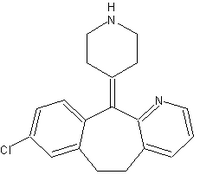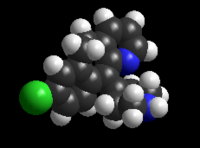The giant Clarinex pill comes spinning out at you in the new ads, promising "all day, all night, all year allergy relief." The ads, which seem to be everywhere, are part of a massive campaign by the Schering Corporation to sell the idea that Clarinex is an improvement over Claritin. It isn't--but more on that later.
Both drugs are produced by the Schering Corporation, whose ads signify a desperate attempt to maintain market share. The patent is about to run out on Claritin, the most profitable antihistamine of all time with annual sales of more than $2 billion. Schering is not the first company to introduce a "new" drug to compete with its own blockbuster in the months before patent protection expires and the cost drops considerably. Last year, AstraZeneca introduced Nexium, purported to be an improvement over its enormously successful heartburn drug, Prilosec. There is one difference, however, Prilosec will remain a prescription drug, albeit sold by generic companies at two-thirds the current cost. By the end of the year, Claritin is expected to be available over the counter at a more precipitous reduction in its current cost of $85 for a month's supply.
In both cases, the "new" drug is merely a knock-off of the blockbuster drug. And Claritin's efficacy was marginal to begin with. The drug is no more effective than older, cheaper antihistamines. Lack of drowsiness was supposed to be its advantage over older antihistamines.
Two FDA-required trials showed that Claritin is better than a placebo (sugar pill), but not by much. At 10-milligram doses, Claritin was only 11% more effective than a placebo. However, taken at higher, more effective doses, the drug causes drowsiness. It was not in Schering's interest to conduct a head to head comparison of Clarinex and Claritin, nor was the company required to do so by the Food and Drug Administration. The FDA merely requires testing to prove that Clarinex is better against seasonal allergies than a placebo.
In the fine print of Clarinex ads there is plenty of information about adverse reactions, but no information about how successful the drug is for the treatment of allergies. This is typical of 90% of all drug advertising. The Clarinex tests were conducted with daily doses of 5 mg tablets. The combined results of all tests showed that symptoms were reduced, at best, by 30% in the people taking Clarinex, as compared to 22% in those taking the placebo. The 8% difference was enough to get the go-ahead from the FDA. Symptom relief generally lasted for 24 hours after each dose. Testing was done with people over age 12, therefore there is no information about Clarinex's safety and efficacy in young children.
Clarinex has been available in Europe for months. In the absence of studies that compared this drug against Claritin, The European Agency for the Evaluation of Medicinal Products (EMEA) reviewed all the studies conducted on both drugs. According to the Washington Post, the EMEA concluded that Clarinex is "probably not superior" to Claritin. The EMEA is currently looking at a possible link between Claritin use in early pregnancy and birth defects.
Adverse effects of Clarinex are minor, as reported in the short-term FDA- required trials (four weeks, at best). For example, 4% of the people taking Clarinex had sore throats, but so did 2% of those on the placebo. Animal studies produced the most worrisome information about Clarinex. In doses of Clarinex far higher than would be taken by humans, rats showed higher rates of liver tumors and reduced fertility due to decreased sperm count. Clarinex is also approved for the treatment of chronic hives. Tests that lasted six weeks showed that Clarinex reduced the number and size of the hives. An FDA advisory panel approved the same use for Claritin last month. The agency doesn't have to follow the recommendations of its panels, though it usually does.
Many consumers have been self-treating hives with Benadryl, a drug from the older generation of antihistamines long available over the counter. Although the newer generation of antihistamines--Clarinex, Claritin, Allegra, Zyrtec--currently cost more, they are the preferred choice. The older drugs can impair psychomotor performance [dexterity] even when they do not cause sedation, according to The Medical Letter (3/18/02), a professional publication with no drug advertising.
MaMaryann Napoli is the associate director of the Center for Medical Consumers in New York City.
COPYRIGHT 2002 Center for Medical Consumers, Inc.
COPYRIGHT 2002 Gale Group



